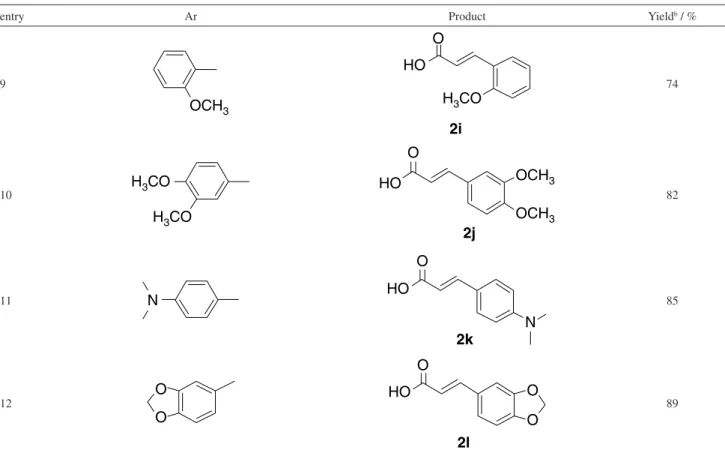Short Report
S
Printed in Brazil - ©2013 Sociedade Brasileira de Química 0103 - 5053 $6.00+0.00*e-mail: jimin@seu.edu.cn
Solvent-Dependent Regioselective Oxidation of
trans
-Chalcones using
Aqueous Hydrogen Peroxide
Peng Wang,a Jin Cai,b Jiabin Yang,a Chunlong Sun,b Lushen Lia and Min Ji*,b
aSchool of Biological Science and Medical Engineering and bSchool of Chemistry and Chemical
Engineering, Southeast University, Nanjing 210096, P. R. China
Um novo método para oxidação regiosseletiva de trans-chalconas com peróxido de hidrogênio
em acetonitrila para fornecer ácidos cinâmicos é reportado. Somente os ácidos trans-β-arilacrílicos
foram obtidos. Um largo intervalo de produtos funcionalizados pode ser efetivamente produzido a partir de várias chalconas com rendimentos de bons a excelentes.
A novel method for regioselective oxidation of trans-chalcones with hydrogen peroxide in
acetonitrile to afford cinnamic acids is reported. Only trans-β-arylacrylic acids were observed.
A wide range of functionalized products can be effectively produced from various chalcones in good to excellent yields.
Keywords: cinnamic acid, chalcone, regioselective, solvent-dependent
Introduction
The oxidation reaction, especially that of α,β-unsaturated ketones is an important method for the conversion of functional groups in organic synthesis.1-4 Hydrogen peroxide is an environmentally benign oxidant as the only by-product after oxidation is water.5,6α, β-Unsaturated ketones can be oxidized to various oxidation products by hydrogen peroxide in different reaction conditions,7,8 including products of oxygen insertion and epoxidation reactions. However, few reports mention that α, β-unsaturated acids can be obtained from α, β-unsaturated ketones using hydrogen peroxide as the oxidant.
Arylacrylic acids especially cinnamic acids are useful and versatile intermediates in organic synthesis, which can be used in flavors, synthetic indigo and certain pharmaceuticals.9-11 Several methods have been reported in the literature for the synthesis of cinnamic acids. Currently, they are commonly obtained by two methods: (i) the reaction of various benzaldehydes with malonic acid in the presence of different catalysts such as pyridine, piperidine and others;12,13 (ii) palladium-catalyzed Heck reaction of aryl halides and acrylic acid.14,15 But these reactions are of some disadvantages such as being sensitive to water or oxygen. Dakin oxidation, which can convert
2-hydroxybenzaldehyde or 4-hydroxybenzaldehyde to benzenediol, has been commonly used in the synthesis of phenols. However, to the best of our knowledge, access of arylacrylic acids by the Dakin oxidation has not been reported to date. Herein, it is reported a unique and highly selective of chalcones using K2CO3 as base in acetonitrile under mild conditions, and versatile arylacrylic acids are directly formed from chalcones in good yields and with excellent regioselectivities.
Tanaka et al.16recently reported that 2’-hydroxychalcones can be oxidized to flavanols in a water suspension medium and have better yields than in an ethylenediamine-dioxane system, while in acetone-water, the epoxides were obtained as the main products.17,18 Our group envisioned that solvents might play an important role in the oxidation of chalcones and potentially alter product distribution.
Results and Discussion
To test this hypothesis, our group started the study on the oxidation of 2’-hydroxychalcone (1a) in the presence of the K2CO3-H2O2 system at room temperature. To our delight, the oxidation of 2’-hydroxychalcone indeed afforded cinnamic acid in 90% yield in acetonitrile.
some of the results. From these experiments, it was found that trans-cinnamic acid was obtained in high conversion and good yield, employing K2CO3 as the base in acetonitrile at room temperature. Under this condition, pyrocatechol as the lost part of chalcone is not stable,19,20 and can be removed during the water washing step. On the other hand, no product was observed in toluene, dioxane and water. Ionic liquid [bmim][BF4] used as solvent was also examined.
21
However, traces of trans-cinnamic acid (2a) were observed even though NaOH was employed as the base. The Dakin oxidation of aromatic aldehydes using H2O2/H3BO3 in the presence of sulfuric acid was reported.22 However, it is ineffective for the oxidation of 1a.
Encouraged by these results, different alkali metal carbonates and organic base for the oxidation of 1a at room temperature were screened (Table 1). In contrast to Na2CO3, higher yield of 2a was observed employing K2CO3 as the base. The yield evidently went down from 90 to 79% when the amount of K2CO3 was reduced to half. However, the yields sharply decreased in Cs2CO3 and diethylamine conditions in which 3-hydroxyflavanone is the main byproduct. The application of NaOH had no
obviously yield increase effect, except short reaction time. From an environmental point of view, it was employed K2CO3, an inexpensive and safe base, for following research.
With an optimized oxidation system in hand, it was then examined the generality of this protocol. As shown in Table 2, all reactions proceeded smoothly and afforded the desired products in good to excellent yields upon isolation. Notably, the halogen substituted chalcones needed more reaction time to afford the corresponding arylacrylic acids in good yields. Electron-withdrawing and electron-donating substituents on the benzene ring were also tolerated. For example, cinnamic acids with o-methoxy and p-methoxy groups can be obtained in favorably yields. The nitro-substituted chalcones can be employed to produce the nitrocinnamic acids in excellent yields. It was observed that electron-withdrawing substrates exhibited more reactivity than electron-donating substrates. However, the dimethylamino group has little effect on the reactivity of reaction with a yield of 85%. Interestingly, (E)-3-(benzo[d] [1,3]dioxol-5-yl)acrylic acid can also be successfully prepared.
Scheme 1. Oxidation of chalcones using aqueous hydrogen peroxide in acetonitrile.16
Table 1. Optimization of solvents and base for the oxidation of 2’-hydroxychalconea
entry Solvent Base time / h Yieldb / %
1 toluene K2CO3 24 ND
2 water K2CO3 24 ND
3 dioxane K2CO3 24 ND
4 [bmim][BF4] K2CO3 12 trace
5 acetonitrile K2CO3 5 90
6 acetonitrile Na2CO3 5 60
7 acetonitrile Cs2CO3 5 75
8 acetonitrile Et2NH 5 45
9 acetonitrile NaOH 1 90
10 [bmim][BF4] NaOH 12 trace
11c [bmim][BF
4] − 12 NR
12d acetonitrile K
2CO3 12 79
aReaction conditions: unless otherwise specified, all reactions were carried out with 1a (1 mmol), base (10 mmol) and 30% H
2O2 (0.5 mL) at room temperature; byield of isolated product 2a; cusing H
Table 2. Oxidation of various chalcones with hydrogen peroxidea
entry Ar Product Yieldb / %
1 90
2c 85
3c 87
4 84
5 91
6 78
7 75
Table 3. The synthesis of trans-cinnamic acid from various chalconesa
entry R1 R2 R3 time / h Yieldb / %
1 OH H H 5 90
2 OH H Cl 5 88
3 H OH H 24 NR
4 H H H 24 NR
5 OH H OCH3 4 91
6 H H OH 6 87
7 H H OCH3 5 82
aReaction conditions: unless otherwise specified, all reactions were carried out with 1 (1 mmol), K
2CO3 (10 mmol) and 30% H2O2 (0.5 mL) in 1 mL acetonitrile at room temperature; byield of isolated product; NR: no reaction.
entry Ar Product Yieldb / %
9 74
10 82
11 85
12 89
aReaction conditions: unless otherwise specified, all reactions were carried out with 1 (1 mmol), K
2CO3 (10 mmol) and 30% H2O2 (0.5 mL) in 1 mL acetonitrile at room temperature for 5 h; byield of isolated product; creaction time: 12 h.
Table 2. continuation
To understand this oxidation further, it was focused on the substituents on the other phenyl. Clearly, it can be found that the position of hydroxyl on this phenyl ring is critical for this transformation (Table 3). 2’-Hydroxy chalcone
Experimental
General methods
Nuclear magnetic resonance (NMR) spectra were recorded on a Bruker-300 MHz spectrometer. Chemical shifts are reported relative to TMS (tetramethylsilane), coupling constants are given in hertz. Melting points were measured on a WRS-2A melting point apparatus and are uncorrected. Commercial reagents were used as received. Analytical-grade solvents and commercially available reagents were used without further purification.
General procedure
To a 5 mL round bottom flask equipped with a stir bar, trans-2’-hydroxychalcone 1a (1 mmol), K2CO3 (1.38 g, 10 mmol), 35% H2O2 solution (0.5 mL) and 2 mL acetonitrile were added. The reaction was stirred at room temperature and monitored by TLC (thin layer chromatograph) until disappearance of the starting material. The solvent was evaporated with reduced pressure. To the residue, it was added 1 mol L-1 hydrochloric acid, the solid was filtered to afford 2a as white solid (133 mg, 90%); 1H NMR (300 MHz, DMSO-d
6) d7.58 (d, 1H, J 16 Hz),
7.42-7.69 (m, 5H), 6.53 (d, 1H, J 16 Hz); 13C NMR (300 MHz, DMSO-d6) d 167.7, 144.0, 134.3, 130.3, 128.9, 128.2, 119.3.
Conclusions
In conclusion, it was reported a novel method for the regioselective oxidation of chalcones with hydrogen peroxide in acetonitrile to afford cinnamic acids, utilizing K2CO3 as the base. Only trans-β-arylacrylic acids were observed. A wide range of functionalized cinnamic acids can be effectively produced from various chalcones in good to excellent yields. Our group is convinced that this procedure is and will be of significant value for the synthesis of a variety of trans-β-arylacrylic acids, which are important for organic chemistry.
Supplementary Information
Supplementary data are available free of charge at http://jbcs.sbq.org.br as a PDF file.
Acknowledgments
This work is supported by the National Basic Research Program of P. R. China (No. 2011CB933503) and
Technology Supporting Program of Jiangsu province (BE2009639, BE2012657).
References
1. Adger, B. M.; Barkley, J. V.; Bergeron, S.; Cappi, M. W.; Flowerdew, B. E.; Jackson, M. P.; McCague, R.; Nugent, T. C.; Roberts, S. M.; J. Chem. Soc., Perkin Trans. 11997, 3501. 2. Bunton, C. A.; Minkoff, G. J.; J. Chem. Soc. 1949, 665. 3. Jakka, K.; Liu, J. ; Zhao, C.-G.; Tetrahedron Lett.2007, 48,
1395.
4. Lu, X.; Liu, Y.; Sun, B.; Cindric, B.; Deng, L.; J. Am. Chem. Soc.2008, 130, 8134.
5. Gallo, R. D. C.; Gebara, K. S.; Muzzi, R. M.; Raminelli, C.;
J. Braz. Chem. Soc.2010, 21, 770.
6. Alizadeh, M. H.; Tayebee, R.; J. Braz. Chem. Soc.2005, 16, 108.
7. Yamaguchi, K.; Mori, K.; Mizugaki, T.; Ebitani, K.; Kaneda, K.; J. Org. Chem.2000, 65, 6897.
8. Levine, S. D.; J. Org. Chem.1966, 31, 3189.
9. Singh, T. S.; Mitra, S.; Spectrochim. Acta, Part A 2011, 78, 942. 10. Brožič, P.; Golob, B.; Gomboc, N.; Rižner, T. L.; Gobec, S.;
Mol. Cell. Endocrinol.2006, 248, 233.
11. Adisakwattana, S.; Sookkongwaree, K.; Roengsumran, S.; Petsom, A. ; Ngamrojnavanich, N.; Chavasiri, W.; Deesamer, S.; Yibchok-anun, S.; Bioorg. Med. Chem. Lett.2004, 14, 2893. 12. Khosropour, A. R.; Khodaei, M. M.; Moghanian, H.; J. Chem.
Res. 2005, 364.
13. Mitra, A. K.; De, A.; Karchaudhuri, N.; Synth. Commun.1999,
29, 573.
14. Plevyak, J. E. ; Dickerson, J. E. ; Heck, R. F. ; J. Org. Chem.
1979, 44, 4078.
15. Tang, Y.-Q.; Chu, C.-Y. ; Zhu, L.; Qian, B.; Shao, L.-X.;
Tetrahedron2011, 67, 9479.
16. Tanaka, K.; Sugino, T.; Green Chem.2001, 3, 133. 17. Husain, A.; Shaharyar, M.; Asian J. Chem.2005, 17, 624. 18. Krow, G. R.; Org. React.1993, 43, 251.
19. Brecht, E. A.; Rogers, C. H.; J. Am. Pharm. Assoc.1940,
29, 178.
20. Wieland, H.; Franke, W.; Justus Liebigs Ann. Chem.1927,
457, 1.
21. Zambrano, J. L.; Dorta, R.; Synlett2003, 1545.
22. Roy, A.; Reddy, K. R.; Mohanta, P. K.; Ila, H.; Junjappa, H.;
Synth. Commun.1999, 29, 3781.


